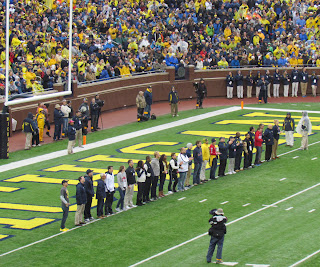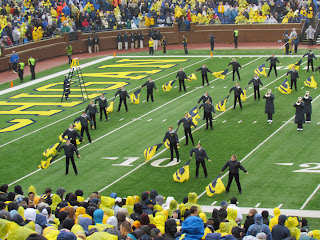I left Grand Marais very early last Friday to head down state. It had snowed and sleeted over night so the roads were quite icy for the first couple of hours of driving. I went to Mount Pleasant for a day to visit with my college friend, Steve. It was a beautiful day so we went golfing. Since I was so busy all summer, it was just the second time all year that I was able to hit that little white ball around. Then I left early Saturday morning and headed south. I met up with my sister, Diana, at my son's house in South Lyon and then we drove down to Ann Arbor.
I have learned over the years that it is a lot easier to park on campus and walk over to the stadium. We walked down State Street toward the stadium.
There was a lot of evidence of homecoming celebration.
Since it was raining, most people waited to enter the stadium until just before kick off.
We had terrific seats on the 35 yard line, thanks to my friend, Steve, who was able to secure the tickets.

Through Fielding Yost's dogged perseverance, the Regents approved the new stadium on April 22, 1926. Although Yost originally wanted to build the new stadium where the Michigan Golf Course is now located, that plan was denied. Instead, this new structure was to be built on land the University had purchased in 1925, land that at one time had been home to a barn, a strawberry patch and an underground spring that had served the University's water needs in the early years. The water posed a problem to the construction, as the land had to be lowered to take care of a large underground lake. The underground lake also led to a surface which nearly resembled quicksand. It was this moist ground that during construction, engulfed a crane which, according to legend, remains under the stadium today. The high water table also led to nearly three-quarters of the stadium being built below ground level.
After much debate, the Regents, the University of Michigan and Fielding Yost reached an agreement by which the stadium would seat 72,000. However, Yost was able to influence the plans so the stadium could be expanded to seat more than 100,000. The construction was financed not by the taxpayers of the State of Michigan but by the sale of 3,000 $500 bonds that entitled the bondholders to buy season tickets (guaranteed between the 30-yard lines) for every season from 1927 until the bonds would be retired in 1936.
With Yost's successful promotion, the bonds sold and construction began. Fashioned after the Yale Bowl, 440 tons of reinforcing steel and 31,000 square feet of wire mesh went into the building of the 44-section, 72-row, 72,000-seat stadium at a cost of $950,000. The original seats consisted of 22 miles of California Redwood, and the 360 x 160 foot grass playing field included the planting of one four leaf clover.
On Oct. 1, 1927, Michigan played Ohio Wesleyan in the first game at Michigan Stadium. After a successful first season in which the Wolverines drew nearly 300,000 fans, the capacity of Michigan Stadium was upped to 85,753 prior to the start of the 1928 season. In 1930, the University took advantage of new technology and installed electronic scoreboards at both ends of the stadium, becoming the first stadium to use electronic scoreboards for official game time.
Michigan's shutout of Purdue on Nov. 8, 1975 began its current streak in which the Wolverines played every home game in front of more than 100,000 fans. I was in college at the time. If my memory serves me, I believe the game just before that -- which was the last game with an attendance of less than 100,000 -- was against Navy.
Let the game begin...
Because it was homecoming, there were many people honored during the game. Below is a picture of Olympic athletes, coaches and trainers from the University of Michigan.
The Michigan band put on a great half time show.
UofM did well winning the game 45-0.
The 37 year old streak with more than 100,000 people in attendance continued....
It rained during most of the game, although we were dressed for the weather. We did leave with around six minutes in the game to head back to our car. Then we had a great dinner with Steve and our group of 14 at the Gandy Dancer restaurant. Pictured below is Diana in front of the rotating cube.





















No comments:
Post a Comment